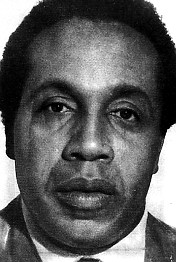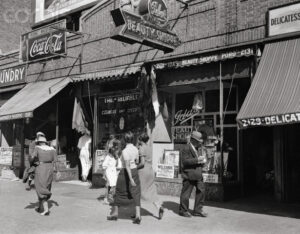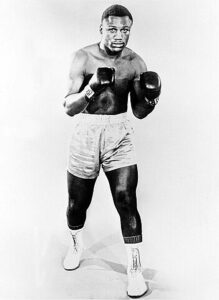If you lived in Harlem during the 1970s and you were looking to score some dope, there were a multitude of options available to you. You had Mean Machine, Ding Dong, Taster’s Choice, Harlem Hijack, Tragic Magic, Rush, Official Correct, and that’s just the ones we can say without getting demonetized. But none of them compared to Blue Magic, Frank Lucas’s product that was at least ten percent pure heroin when all his competitors only offered five, even three percent purity.
According to the man himself, at the height of his power during the early-1970s, his criminal empire was spending $200,000 a week on police bribes alone, but that was nothing since it raked in over $1 million a day in drug sales, with over $300 million worth of heroin stockpiled in his secret stash. Lucas owned property in New York, Miami, Los Angeles, Detroit, Puerto Rico, and North Carolina, and when he wasn’t busy spending millions on cars, clothes, jewelry, or flying to Paris just for a nice lunch, he was palling around with the rich and famous like James Brown, Joe Louis, and Diana Ross.
In an interview he gave in 2000, Frank Lucas said that he “always knew (his) life was a movie.” And he was right, as seven years later, his story was up on the silver screen, with Denzel Washington playing him in the film American Gangster, which told the tale of how Frank Lucas became one of the biggest drug kingpins in the history of New York City.

Early Years
Despite his strong association with Harlem, Frank Lucas was not a native New Yorker. He was actually born in La Grange, North Carolina, on September 9, 1930, the oldest boy of Fred Lucas and Mahalee Jones. Right off the bat, we should specify that Frank Lucas was a man who, let’s say, had a peripheral relationship with the truth. Nobody thought that Frank Lucas was a badass motherlover more than Frank Lucas himself. He enjoyed the sound of his own voice and gave plenty of interviews later in life that then formed the basis for the biographies on him. He even co-authored his own self-aggrandizing autobiography in 2010, which we used liberally for this video, but the veracity of many of his statements and claims has fallen under a cloud of skepticism and dubiousness. Or, to put it plainly, we are not sure what actually happened and what Lucas made up to make himself feel more important.
A perfect example of this is one of young Frank’s first formative experiences, the one which he claimed set him on the path of a life of crime. When he was only six years old, living out in the sticks of North Carolina in a rundown, one-room shack during the Great Depression, the family had Frank’s older cousin, Obadiah, staying with them. One night, several armed members of the KKK showed up in front of the house, dragged Obadiah out of the house, and beat him up for looking at a white woman. They then killed him right in front of Frank with a shotgun blast to the head and the local sheriff made sure that the men got away with the murder.
If true, then this kind of traumatic event would certainly have an effect on anybody, especially a small child, but investigators have failed to uncover evidence to support Lucas’s claim. So maybe it was an absolutely heinous murder that went unpunished, or it was something Frank Lucas made up as an excuse for his crimes. We can’t really tell, but one thing is for sure – this will not be Lucas’s last claim to garner more than its fair share of doubts and controversy.
Anyway, from that point on, Frank Lucas was an innocent child no more. The harsh realities of life for a poor Black family in the American South during the Great Depression had hardened him prematurely and he began doing whatever was necessary to help out his parents and younger siblings. He started out by sneaking into farms to steal eggs and chickens. Afterward, he escalated to robbing drunks, by waiting for them to leave bars or brothels, and whacking them over the head with a bat. Violence quickly became not only a routine for Lucas but the default way that he would solve his problems. As a teenager, he found a regular job as a truck driver for a pipe company, but that went south when the boss caught him sleeping with his daughter. Frank’s solution was to cosh him on the head with a lead pipe, steal his money, and set the business on fire.
This was far more extreme than any other crime Lucas had committed up until that point. He knew that something like this would not go unanswered and that he needed to go somewhere far, far away. So in the summer of 1944, he boarded a Greyhound bus and rode it all the way to the corner of Fiftieth Street and Eighth Avenue, in New York City. He then got on another city bus which took him to 114th Street in Harlem, the location where he would establish his criminal empire.
A Menace to Society
Frank Lucas might have made it to Harlem, but he was penniless, jobless, and homeless, and did not know anyone who could help him remedy that situation. Therefore, unsurprisingly, he resumed his unlawful ways. His technique was hardly the work of a master criminal. Lucas saw somebody carrying money, he would wallop them over the head with whatever was handy, take the money and run. It didn’t matter to him if it was a delivery man or some two-bit gangster collecting money for a numbers racket. Anyone was fair game, as far as he was concerned. By the time he had stolen enough money to rent a room and buy himself a gun, Lucas was a self-described “menace to society.”
Now that he was packing heat, Lucas got brazen and started robbing places instead of random people on the street. Bars, bodegas, grocery stores, clothing shops, he hit them indiscriminately, but they all paled in comparison to Frank’s next target – a gambling den known as the Big Track.
It all started after Lucas robbed a jeweler and made off with some loose diamonds. He didn’t really know anyone who could handle that kind of merchandise, but he was eventually introduced to a gangster named Cool Breeze, who offered him 30 grand for the stones like it was loose change. For most other people in Harlem, Cool Breeze was the kind of guy they wanted to avoid and if they couldn’t, they tried to stay on his good side, but as far as Lucas was concerned, he just saw him as a big, fat, juicy target.
By following Cool Breeze around, Lucas discovered the Big Track, a gambling hall in the basement of a hotel where other gangsters with deep pockets went to shoot craps and play cards for big stakes. Other robbers might have considered the Big Track as impregnable as Fort Knox, but Lucas was the proverbial kid in the candy store. After going there a few times to case the joint, he made his way to the Big Track one day armed with two guns and had everyone line up against the wall and take their clothes off so they wouldn’t follow him out after he absconded with their money. Most of the men in there obeyed Lucas with stunned silence, more shocked than angry that someone would have the audacity to rob them, except for one guy named Fat Daddy who mouthed off at Lucas and got shot in the ass for his troubles.
After the heist, Lucas assumed that he was the most wanted man in Harlem, but he continued his activities, as usual, not really caring whether he lived or died. One thing’s for sure, though, he never went anywhere without a gun in his pocket. But, for whatever reason, the hit he assumed would come never did. Something else did happen, though, which had a tremendous impact on Lucas’s life, as he was introduced to the man who would help him become the new kingpin of Harlem.
A Disciple of Bumpy Johnson
As Lucas tells it, one day he was at Metin’s Pool Room at 118th and 7th Avenue. A guy he knew only as Icepick Red walked in, flush with cash, looking for challengers willing to put up $1000 a game. Now, as far as Lucas knew, Icepick Red earned his name by working as a killer-for-hire who was willing to murder anyone for $25,000. His preferred method was to simply walk up to his target in the street and stab him in the chest with an icepick before running away. This didn’t deter Lucas, who approached Icepick and challenged him to a game, even though he only had $3 in his pocket. Red was about to go off on Lucas when someone walked into the pool hall. He wore an expensive dark blue suit with a red tie and red lapel, and made everyone stand at attention in silence even though he was about 5’9” and 160 pounds. That man was Bumpy Johnson and he owned the streets of Harlem.
Bumpy walked up to Lucas, who was still a kid at the time, and asked him if he can beat Icepick. Lucas said “yes” and Bumpy gave the order to rack the balls, fronting the money for him. Lucas won the pool game and everything else, according to him, was history. Afterward, Johnson took Lucas in his car and rode around to everyone who had a grudge against him – Cool Breeze, Fat Daddy, every store owner he ever robbed – and made it clear that the kid was with him now and that nobody was allowed to touch him. They all just had to sit there with a smile on their face and bear it. After that, Lucas became Bumpy’s right-hand man and a student of the game, spending years under his learning tree as he was taught everything there was to know about being a mob boss, until 1968 when Bumpy Johnson passed away, thus paving the way for Frank Lucas to take over.
That is the story according to Frank. Not everyone agrees with it, though, and other people in Johnson’s life, including his own wife Mayme, said that Lucas greatly exaggerated the mentor-mentee relationship between him and Bumpy. In fact, Mayme Johnson even said in her own book that Bumpy actually took another kid named Flash Walker under his wing and that Lucas simply took that relationship which he saw firsthand, and claimed it as his own.

In his defense, Lucas said that Bumpy kept home life and business strictly separated and that his wife was not aware of most things he was involved with, but unfortunately for him, the timeline works against him, as well.
The one thing we do know for certain was that Bumpy Johnson enjoyed an 11-year forced vacation at the luxurious and scenic Alcatraz Federal Penitentiary on a drug conspiracy charge, between 1952 and 1963. What happened during this time, we cannot say because Lucas glosses over this tiny detail in his bio and only makes a few quick references. Instead, he prefers to jump ahead to the late 60s, recalling the event where Bumpy allegedly died in his arms at Wells’ Restaurant of heart failure.
Whatever the truth might have been, the reality was that Bumpy Johnson was dead, and Frank Lucas was ready to take over Harlem.
The Cadaver Connection
Frank Lucas had no problem admitting that he was a completely different man from Bumpy Johnson. He saw Bumpy as a generous neighborhood hustler, who wanted to share the wealth and look after the small businesses and mom-and-pop stores in Harlem. Lucas, on the other hand, fully intended to give in to his greed and keep everything for himself. He saw his operation as a lot grander than the small-time numbers and protection rackets that were common in Harlem back then. Drugs were where the real money was and Lucas already had an ambitious plan in mind.
Ever since he still worked for Bumpy, Lucas got the idea of traveling to Southeast Asia and buying heroin straight from the source, thus eliminating the middleman and maximizing their profits. Back then, the area where Thailand, Laos, and Myanmar met, known as the Golden Triangle, was the biggest opium producer in the world. However, when he suggested this to his boss, Bumpy said “no” and that was the end of the discussion. But now that Bumpy wasn’t around, anymore, the plan was back on the table, and Lucas had no intention of waiting. A few days after Johnson’s funeral, Frank was on a flight to Thailand.
Lucas did not have any connections in Asia, but he knew that if he followed the trail of junkies long enough, eventually they will lead him to the source. Bangkok was teeming with American GIs, so Lucas frequented some soldier bars and found plenty of servicemen willing to sell him heroin, but only a key here and two keys there. None of them could provide him with dope on the scale that he envisioned. Plus, they were all getting their drugs from somebody else, and the whole point of Lucas’s plan was to buy straight from the source and eliminate all middlemen.

Eventually, word got around that Lucas was looking to buy and the source came to him. It was a Chinese man, dressed in a nice suit, riding around in a white Rolls-Royce, whom Lucas only referred to as “007” because he thought he looked like the Asian James Bond. The two of them quickly formed a profitable relationship. Lucas had the money and 007 had all the heroin he could ever want being delivered straight from the hidden jungles inside the Golden Triangle. The dealer even had a way of smuggling the drugs out of the country and into the States, on military planes. He introduced Frank Lucas to US Army Master Sergeant Ike Atkinson, better known as Sergeant Smack. Together, they came up with the notorious Cadaver Connection, named after the fact that Lucas smuggled drugs inside the coffins of dead servicemen being repatriated to the United States. The way Lucas tells it, he brought a carpenter from North Carolina to make his special coffins:
“We had him make up 28 copies of the government coffins … except we fixed them up with false bottoms, big enough to load up with six, maybe eight kilos … It had to be snug. You couldn’t have s**t sliding around. Ike was very smart, because he made sure we used heavy guys’ coffins. He didn’t put them in no skinny guy’s.”
That was one smuggling run out of a few dozen over the course of approximately six years. On another occasion, Lucas bragged that he smuggled 125 keys aboard the plane of US Secretary of State Henry Kissinger by bribing a general a hundred grand to look the other way.
The story about the Cadaver Connection came from Lucas himself in an interview and, later, he reaffirmed it in his own bio. Just one small problem, though – everyone else has called BS on it. The DEA said it was a lie, the federal judge who tried Lucas said it was a lie, and a researcher and biographer called it “the biggest hoax in the history of the international drug trade.”
Even Ike Atkinson, good ol’ Sergeant Smack, said it was not true. In fact, Atkinson said a lot more than that. Once again, Frank Lucas was being accused by somebody of taking their story and claiming it as his own in order to make himself more impressive. Sergeant Smack said that he was the one running the international drug cartel and had set up his operation before Lucas even stepped foot in Thailand. He was the one who brought in the carpenter, but he had him build hollow furniture with hidden compartments to smuggle the drugs into the States, not coffins. And Lucas was simply a buyer, one of several, nothing more, nothing less…
We might not know what exactly happened in Thailand, but back in Harlem, there was no doubt that Frank Lucas was making a killing, both figuratively and literally. His product, which he dubbed “Blue Magic,” was cut to 10 to 12 percent purity which was twice as strong as other competitors. He could afford it, after all, since he paid $4,200 a key back in Thailand which was worth at least 50 grand in New York. But while this meant that Lucas had the dopest dope on the street, it also brought about a lot of deaths from overdoses, from addicts who were used to taking much weaker drugs.
But Lucas had no concerns about such matters. He was too busy counting his millions, buying legit businesses to launder his money, and rubbing shoulders with celebs at fancy restaurants and exclusive nightclubs. But we all know that the good times don’t last forever…
American Gangster
The one big problem with living a lavish lifestyle is that it tends to get you noticed and that’s not something you always want. In one notorious instance, Frank Lucas attended the 1971 championship boxing match between Muhammad Ali and “Smokin’ Joe” Frazier wearing a $100,000 chinchilla fur coat and a matching hat worth $25,000. Given that the match was billed as the “Fight of the Century” and was, without a doubt, one of the most publicized sporting events in history, Lucas attracted a fair bit of attention, just not from the people he expected. Even he admitted that, as far as the DEA was concerned, Lucas came to the fight as an unknown and left it “a marked man.”
“Blue Magic” was already known to the feds, but the man behind the dope was a mystery. Well, not anymore. A task force consisting of DEA and NYPD agents was assigned to deal with Lucas. It took them a few years to build their case, but in early 1975, they executed a raid on his home in Teaneck, New Jersey, and arrested Frank Lucas. He and dozens of his associates were indicted in the years that followed and in 1977 Frank himself was sentenced to 70 years total for one state term and one federal. But curiously enough, he was released on parole after serving only five years.
How did this happen? Well, it is obvious, he became a government informant, and his information led to dozens of arrests of associates and corrupt officials. Just don’t expect him to ever admit to it. Even in his tell-all interview, he refused to discuss the BS “about being buddy-buddy with the cops” and insisted that he never “testified against anyone in court.” Surely, all those decades taken off his sentence must have been because people liked him so much.
Anyway, in 1982 Frank Lucas was a free man again, but the government had confiscated all his ill-gotten gains. That was a bitter pill to swallow for an extravagant man who got used to spending money like it had an expiration date. To nobody’s surprise, Lucas got back to the thing he did best – selling drugs. However, his career renaissance did not last long. He was arrested again in 1984 and got another seven years in prison on new drug charges. This time, he served his entire sentence before being released again in 1991.

This part of his life is a mystery that even Lucas glossed over in his own autobiography. Probably because it didn’t make for an interesting read from a man who, be it fact or fiction, liked to present his life story as the most thrilling adventure ever seen. He insisted that he went straight and laid low, claiming that he made some legit money by using his old connections to organize fundraisers for an oil business. But realistically, Frank Lucas the drug kingpin was gone for good, and it wasn’t until 2000 that Frank Lucas the media celeb emerged.
It all started with his tell-all interview with New York Magazine. After that, Hollywood came a-knocking at his door, wanting to turn his story into a movie. This led to the 2007 Ridley Scott crime film American Gangster, where Frank Lucas was not only played by Denzel Washington, but the real Lucas got to hang around the set and serve as a consultant. The movie was described by the federal judge who tried Frank Lucas as “1 percent reality and 99 percent Hollywood,” and he, too, proclaimed Ike Atkinson to be the true head of the heroin smuggling ring between New York and the Golden Triangle.
But for Frank Lucas, it made little difference. His newfound fame ensured that he spent his final years as a minor celebrity, giving interviews and making appearances at conventions, before dying on May 30, 2019, aged 88.
Frank Lucas’s story was out there for everyone to see. Truth or not, it was the way he wanted it to be told – as the criminal mastermind who first served as a protégé of the infamous Bumpy Johnson, and then took over the streets of Harlem as its most powerful kingpin.



